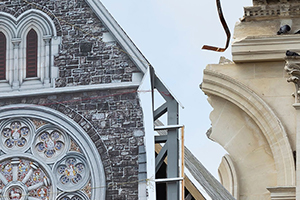
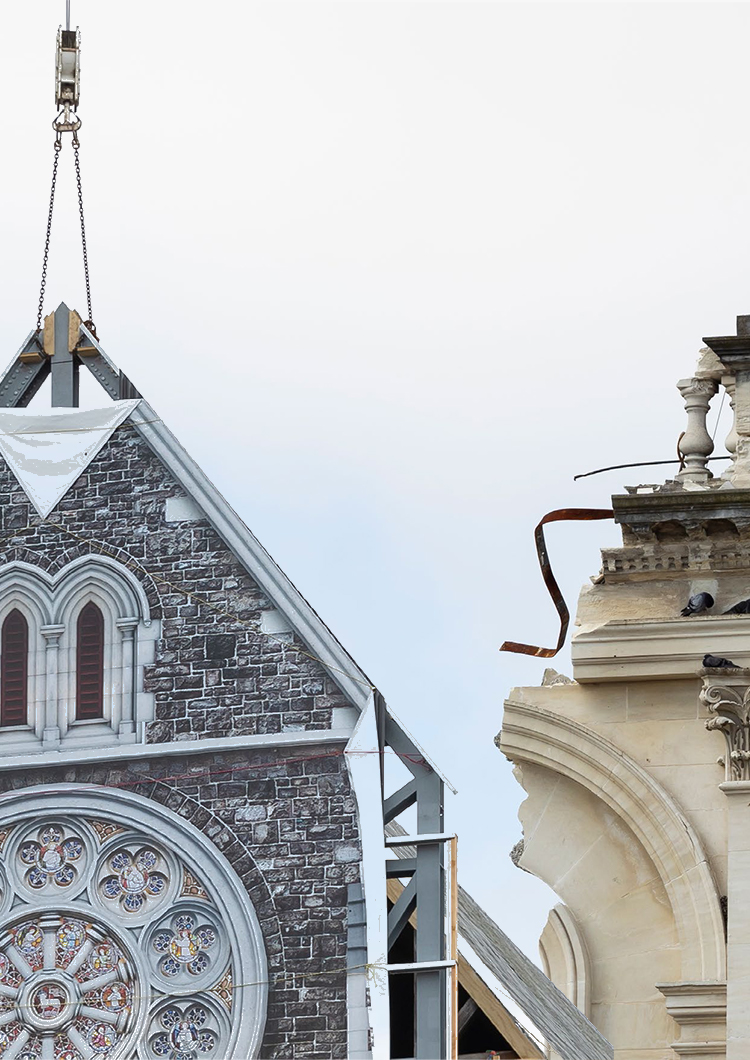
A Tale of Two Churches
Why is Christchurch restoring its Anglican cathedral but destroying the far more architecturally significant Catholic basilica? The answer boils down to politics, real estate and the battle for the city’s future.
By Sally Blundell
Photographs by Sarah Rowlands
On the 12th day of Christmas, behind a barricade of containers and lined fencing, a large excavator rumbles towards the heavy front doors of the Cathedral of the Blessed Sacrament in Christchurch. On either side are growing piles of arched and carved Oamaru and Mount Somers stone, pulled from the colonnaded exterior and razed portico. Ahead are the standing remains of cracked walls, broken windows and doomed scroll-shaped volutes, now the resting place for a cooing population of soon-to-be-evicted pigeons. Since September, a demolition crew has been working its way through the 116-year-old building, methodically picking away at the cornice, frieze and architraves of the Romanesque Catholic basilica once described as the finest Renaissance-style building in Australasia.
The basilica is the lesser-known of Christchurch’s two main cathedrals — the other being the eponymous Anglican ChristChurch Cathedral in the Square. During the earthquake that shattered the city in February 2011, both suffered heart-breaking damage. In 40 seconds, ChristChurch Cathedral’s spire toppled, the top of the tower imploded and part of the roof collapsed. The basilica lost the tops of two towers, its west wall shattered, and its grand dome twisted. The statue of Mary in the window wobbled a full 180 degrees to gaze out at the battered city.
The basilica was the one that was supposed to be saved. While the Anglican bishop, Victoria Matthews, announced plans to pull down her cathedral and replace it with a contemporary one, the Catholic bishop, Barry Jones, seemed determined to preserve his. In 2015, he approved a $45 million project to rescue the nave — the central part of a church’s interior extending from the entrance to the altar. The rest of the Category 1 heritage building would be mothballed until funds could be secured to restore it. Just months after the earthquake, workers began dismantling, recording and storing salvaged materials in an emergency process hailed as a masterclass of sensitive deconstruction. “It lifts the heart just to realise there is a possibility,” Jones told NZ Catholic. “No bishop wants to demolish his cathedral.”
Fast forward 10 years, and the columned arcades, steep arches and ornate balustrade are being ground into rubble and dust. “I can’t watch it,” says heritage campaigner Dame Anna Crighton. “It is vandalism, total vandalism.”
To replace the basilica, the Catholic diocese is preparing to build a huge $126 million cathedral precinct in the inner city, comprising a modern 1000- seat cathedral, as well as an office building, car park and presbytery. This complex is part of an even larger $500 million “North of the Square” collaboration between the Crown, prominent property investor Philip Carter and the Christchurch Catholic Diocese.
In his small diocesan office, Jones’ replacement, Bishop Paul Martin, who gave the green light to the demolition, cuts an authoritative figure. A former bursar general of the Marist Fathers in Rome, he is tall — just shy of two metres — and measured in his responses. The new cathedral, he says, will be a place of “Perpetual Adoration”. All day and all night, “people will be there in prayer or mass”. But he also sees it as a strategic investment in the mission of evangelisation. “The city is gaining momentum as a hive of activity. We will be at the heart of this,” he wrote to his parishioners. “In a world where the things of God are so often discarded, I want us to build a place which says God is incredibly vital to our lives.”
During the same period, the Anglican cathedral has undergone a startling reversal of its own. Its demolition plans have been abandoned, and it has instead embarked on a $154 million programme integrating a fully restored cathedral into a new Cathedral Quarter, including a new visitors’ centre and administration building.
Ten years after a 6.3 magnitude earthquake killed 185 people and wiped a third of buildings from the inner city, the bishops’ moves illustrate competing visions for the future of Christchurch. One church was going to be demolished, now it is being saved. Another was going to be restored, now it is joining the catalogue of heritage buildings falling to the arc and bend of the excavator. Their ultimate fate is less about religion and architecture and more about city politics, competing ideas about heritage and, perhaps inevitably, the imperatives of commercial real estate.
When George Bernard visited Christchurch in 1934, he declared himself amazed that this colonial backwater boasted a cathedral whose beauty measured up to the hallowed churches of Europe. Naturally, his hosts assumed he was talking about the Anglican cathedral. No, Shaw clarified, he meant the “one down by the gasworks” — the Catholic basilica on the edge of the city grid. At a civic reception, he described it as a “New Zealand Brunelleschi”, not a mere copy, “as I regret to state the Anglican cathedral is”.
There is no doubt the Anglican cathedral has played the greater civic role in the life of Christchurch — which, after all, began its existence as a model Church of England settlement. Designed by Gothic Revival architect George Gilbert Scott, the cathedral was placed centre stage in Christchurch’s cross-shaped Cathedral Square. The appointment of Reverend Henry Harper as Canterbury’s first bishop, and his commitment to the planned cathedral, also made made Christchurch New Zealand’s first city in 1856: under British law, the monarch could designate a town a city if it became the seat of a bishop. In the years since, the cathedral has been the focal point for New Year’s Eve celebrations, Anzac Day observances and impromptu community gatherings after events such as 9/11, and soaked up millions in ratepayer grants.
The basilica did not occupy the same foundational place, symbolically or geographically. For much of the city’s history, Catholicism played second fiddle, in terms of population and power, to the Church of England hierarchy. It fell to local Irish immigrants — mainly working class, mainly poor — to raise the money for their own house of worship. In response to the untiring fundraising efforts of Bishop John Grimes, they contributed the lion’s share of the required £52,000. “No one can claim that our stately cathedral is the work of the wealthy,” Grimes said at the basilica’s opening on 12 February 1905. “It is the fruit of the hard earnings of the poor and the lowly, generous to a sacrifice of their well-won pounds, their shillings and their pence.” The basilica remained the main place of Catholic worship in the city for the next 105 years.
George Bernard Shaw described Christchurch’s Catholic basilica as a “New Zealand Brunelleschi”, not a mere copy, “as I regret to state the Anglican cathedral is”.
It was also far more significant architecturally. Francis Petre, an architect born in New Zealand and educated in England, designed a bold, neo-classical building made of concrete sheathed in Oamaru limestone. It was dramatic and richly detailed, with colonnades of columns, ceilings of embossed zinc and a flaming red copper dome that later faded to an oxidised green.
These very different histories may explain the different responses by city residents to the postquake future of the two churches. The decision to demolish the Anglican cathedral was met by a loud and exceptionally well-funded opposition, driven not by the Anglican faithful but by heritage and civic advocates and well-known Cantabrians — what many would call “Establishment” Christchurch. Matthews, the staunch Anglican bishop, was adamant that insurance monies and donations should first be spent on helping those in need. “People before buildings,” she said, again and again.
For years, there were marches, petitions, engineering reviews and a series of legal challenges funded through the Great Christchurch Building Trust (GCBT), led by former local MPs Jim Anderton (a Catholic) and Philip Burdon.
The Key government’s earthquake recovery minister, Gerry Brownlee, was shackled to his infamous statement that “the old dungers, no matter what their connection, are going under the hammer”. But in 2015 he appointed Auckland lawyer Miriam Dean QC to broker a deal between the church and the GCBT, hoping to get some much-needed action happening in the city centre. Mayor Lianne Dalziel offered her support — and a $10 million pledge — for restoration. But a survey of 1000 people in 2014 showed a bare majority of Christchurch residents —51 per cent over 43 per cent — agreed with her. In The Press, actor Sam Neill suggested quietly and respectfully dismantling “the old wreck”. It was, he wrote, too small, too pedestrian, a “pastiche of another time and place”.
The delays and a succession of court cases kept the cathedral in a state of limbo. Even as new developments sprouted around it, the battered structure stood as a painful reminder of the destruction wrought by the earthquake, exposed to rain, snow, pigeons, rats and occasional incursions by urban explorers. Finally, in September 2017, the 225-member Anglican Synod, the governing body of clergy and parishioners, capitulated. Fifty-five percent of its members voted in favour of a $105 million strategy to restore the cathedral. This would be funded through a $42 million insurance payout, a $10 million Christchurch City Council grant, a $10 million Crown cash contribution, a $15 million government loan that will not have to be paid back if certain conditions are met and pledges of close to $14 million made to the GCBT.
Bishop Matthews was bitterly disappointed by this outcome. In 2018, with tears in her eyes, she farewelled her diocese at a special service in the “cardboard” Transitional Cathedral. “It’s business as usual, folks,” she said, “with the wealthy and the powerful telling you, the people of the province of Canterbury, that they know best. Good luck with that.”
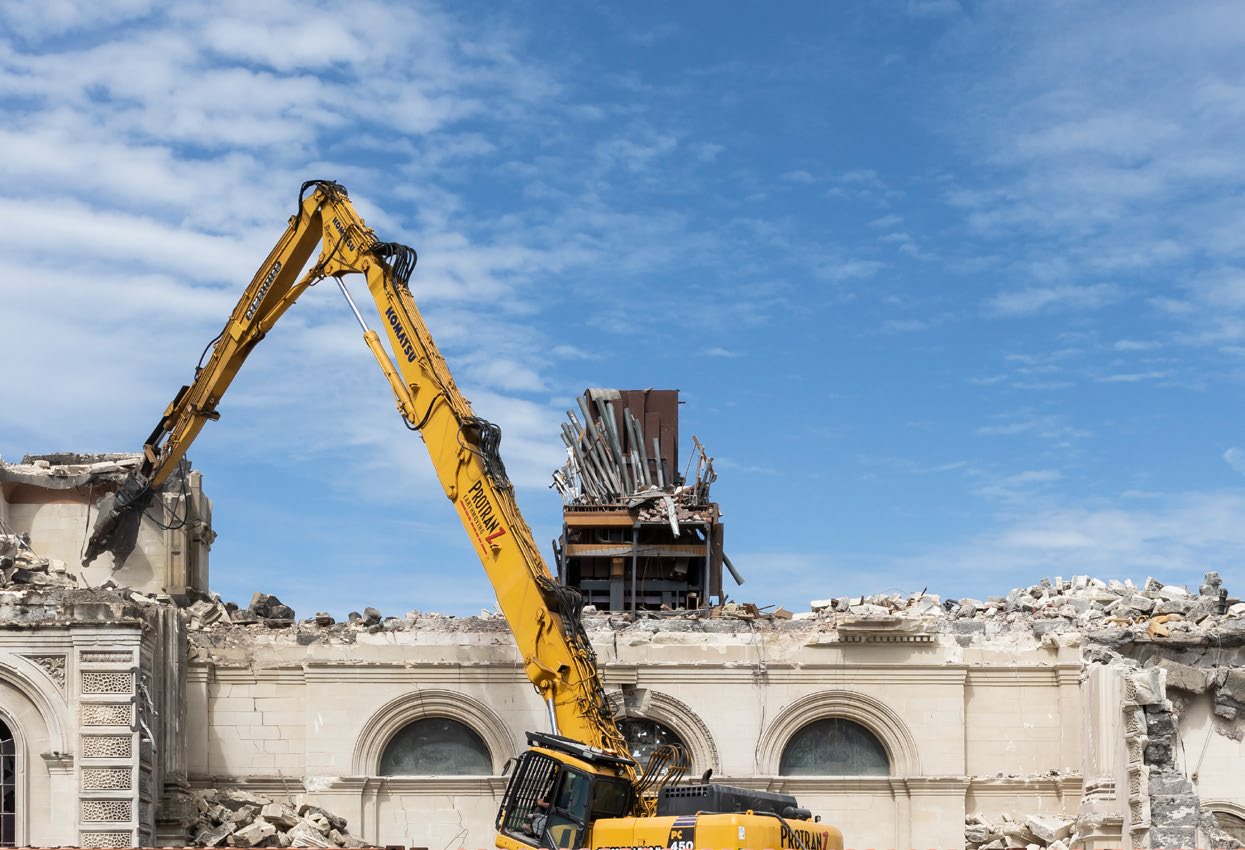
The basilica’s exposed pipe organ.
While the fight over the Anglican cathedral consumed the city and regularly made national news, very little attention was paid to what was happening with the basilica. In 2015, in order to begin the nave restoration, the diocese applied for a section 38 notice under the Canterbury Earthquake Recovery legislation. This notice allowed for the full or partial demolition of buildings — even heritage buildings — without the usual consent or public consultation processes.
Then, in 2016, Jones, who had served as bishop of the diocese for nine years, died. At that point, the save-the-nave restoration project was ready to go. As diocese administrator Father Rick Loughnan told website Cathnews, the possibility of restoring the whole building had been raised, but the final decision had to be left to the new bishop.
Father Paul Martin SM was ordained on 3 March 2018. He did not press go. The total cost of preserving the whole cathedral had climbed from about $100 million to $150 million. The insurance settlement for the entire diocese was $107 million. Other churches needed attention and besides, he says, the busy oneway street on which the broken basilica stood was not conducive to foot traffic.
In July 2019, Martin met with Land Information New Zealand (LINZ), which was by then responsible for section 38 notices. As described in a LINZ memo, the bishop said the diocese had explored all its options and “would be proceeding with full deconstruction of the property”. The following month, unsuspecting parishioners learned that their cathedral was going to be torn down — through a media release.
A small group — mainly heritage advocates — called Restore Our Catholic Cathedral sought legal advice as to whether the demolition would be against the law. It wasn’t. The section 38 notice remains in effect. Originally acquired for the purpose of saving the church, the notice was now being used to speed its demise.
This decision was part of a larger programme of change led by Martin. In June that year, he outlined a plan to close the existing 12 parishes and form five merged ones. The number of churches would be reduced from 20 to five, plus two Mass centres. The diocese’s pastoral letter outlining the plan lists the location of the Christchurch Central parish as “at either Barbadoes Street or on a new site”.
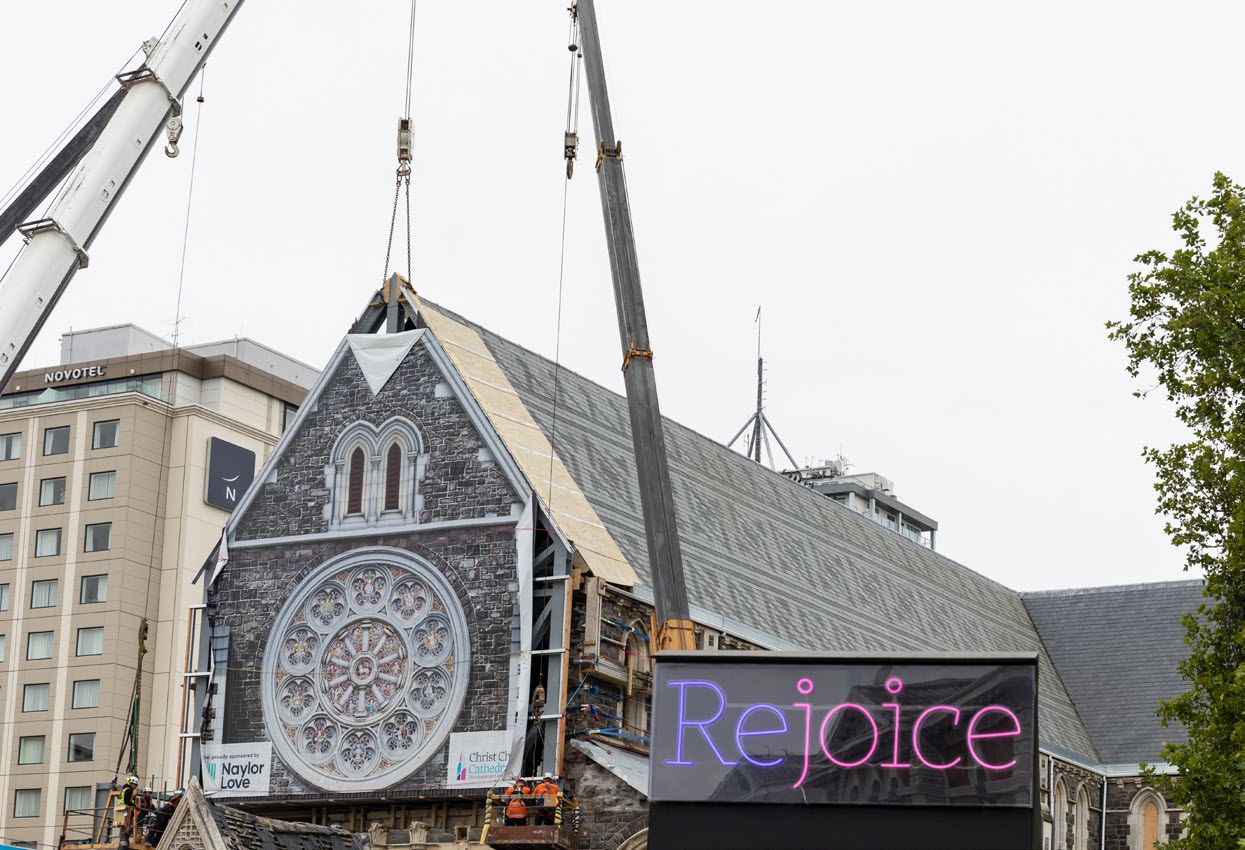
Cranes placing ChristChurch Cathedral’s temporary canvas front.
In 2020, five parishioners from a newly convened Gatherings Group sent a formal petition to the Congregation for the Evangelisation of Peoples in Rome seeking recourse over the plan to reconfigure the parishes. A response has not yet been received. Christchurch writer, film-maker and parishioner Kathleen Gallagher describes the proposal as a corporate, supermarket-type, priest-based plan assuming a shrinking congregation and a shortage of priests. Parishes were full to overflowing, she argues, and a system requiring hundreds of parishioners driving, rather than one priest, was environmentally irresponsible. Announcing a fixed plan and pretending it is a consultation, she wrote in The Press, is “clericalism at its very worst”.
Still, compared to the money and sheer vitriol thrown at Bishop Matthews, public response to the basilica’s impending destruction was muted. Having won its battle for the Anglican cathedral, the GCBT had withdrawn from the limelight. Cantabrians, says Anna Crighton, were exhausted.
Remarkably, she wasn’t. A long-time champion of the city’s architectural heritage, the former city councillor campaigned successfully for the restoration of the Isaac Theatre Royal, the Trinity Church and other heritage buildings. She blames the relative silence following the decision to pull down the basilica on 10 years of aftershocks, personal insurance battles and a “scorched earth policy” fuelled by the “lethal” section 38s that saw around 250 heritage buildings fall to the wrecking ball. “Under the umbrella of all this anxiety and chaos, these things just slip through the cracks.” For the diocese, she says, “It is a perfect time to step in and do what you want.” She believes that if the Church had announced from the outset that it intended to demolish the basilica, there would have been a public opposition campaign “equal or even greater” than the one that fought for the preservation of the Anglican cathedral.
The diocese says there was never a commitment to save the nave and maintains that the work approved by Bishop Jones was only part of a process to ascertain whether restoration was possible.
This is debateable. In 2016, Loughnan, the diocese administrator, assured parishioners in an online newsletter that the diocese believed it could save the nave “and progressively build back other parts over time”. Preliminary geotechnical and engineering investigations of the land and foundations, he wrote, were “positive”. But only when full costings had been done, he added, “will we be making a statement on the future of the cathedral”.
Crighton is unconvinced. “Why would the diocese go to so much trouble cataloguing everything they took down, palletting it and storing it if they had every intention of demolishing it?” she asks. “It was the change of bishop that changed everything.”
Martin disputes this. Everyone thought restoration was going to happen, he concedes. “But that was probably a misunderstanding of what [Bishop Jones] was saying.” As the cost of repairing the entire building ballooned, “it became pretty apparent that it wasn’t going to be doable,” Martin adds. “I can’t second guess what [Bishop Jones] would have done but he would have had to deal with the reality of that figure.
“I always thought [the basilica] was the nicest Catholic building in the country, but the earthquake came and it was very badly damaged and we can see now how dangerous it still is.”
In November 2019, Heritage New Zealand Pouhere Taonga issued a tepid statement, noting that it was “very sad” to learn that the basilica was to be destroyed. “We would prefer they didn’t, but they have a permit,” says southern region director Sheila Watson. “We knew how severely damaged it was and they did put some serious effort into looking at options to repair that building.” Besides, she notes, Heritage New Zealand had no legal ability to intervene (the required archaeological authority only applied to the pre-1900 foundations of a previous church on the site). Parishioners too, it seems, were similarly powerless. “The cathedral is a parish, the bishop is parish priest,” explains Tony Sewell, who leads the diocese property team. “It is his cathedral. So the concept of what we would think is democracy doesn’t occur.”
In 2018, with the basilica’s fate sealed, Bishop Martin began looking for a new rock on which to build his church — a rock preferably closer to the heart of the city.
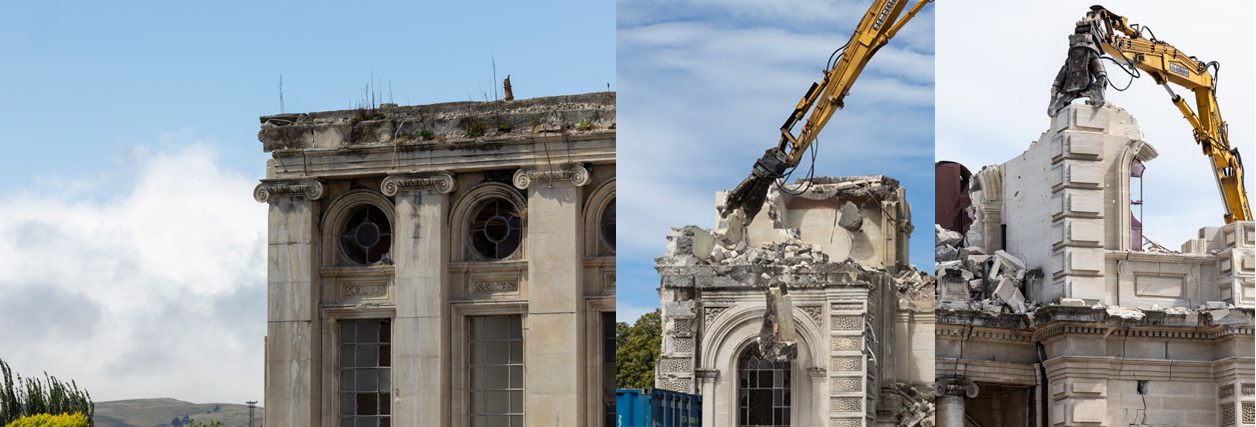
Demolition of the basilica.
In 2011, around 10,000 Cantabrians wrote, posted or drew their ideas of what a rebuilt Christchurch could look like. The City Council’s wildly popular Share-an-Idea event led to a draft plan for a smaller, low-rise city incorporating cycleways, riverfront parks, a performing arts venue, light rail, business incentives and the adaptive reuse of heritage buildings (the resulting fund would be used for the retention of the façade of the 1882 McKenzie & Willis building in High Street). Green initiatives included a rating tool to improve the environmental scorecard of new builds, an upgraded river corridor and more city trees.
Still, recovery minister Gerry Brownlee described the plan as a “pretty big wish list”. While acknowledging the importance of the council’s vision in its city plan, he enlisted the Canterbury Earthquake Recovery Authority (CERA) government agency to set up the Christchurch Central Development Unit (CCDU). The unit was instructed to develop a blueprint in a now-legendary 100 days to “facilitate, coordinate and direct the development of the central city”.
The blueprint organised a shrunken central business area into a matrix of precincts and big-footprint developments including a stadium, sports facility and convention centre. It was a think-big, development-friendly multi-billion rollout intended to give surety to Cantabrians and security to investors.
Some decried the plan as a top-down directive that largely ignored community goals. Others, like prominent developer Philip Carter, welcomed it. One of the city’s richest men, Carter owned a number of properties in the city. Much of his hilltop home in Sumner had plummeted down the cliff in the June 2011 aftershocks. His parents were active in the Catholic church and, as former city councillor and now head of the Carter Group, he has been actively involved in decisions around city planning. A hesitant interviewee, Carter speaks quickly and quietly about the urgent need for investor confidence in a city where an estimated half of commercial property owners reinvested their insurance money outside of Christchurch. “Before the blueprint people were taking their money and running,” he says. “There was no certainty for development, the council wanted everything to be a resource consent.”
Some of the blueprint’s “anchor projects” have been hugely successful. The Margaret Mahy Playground, an innovative riverside adventure playground designed by planners, architects and local school children, is continually alive with shouts and laughter. Tūranga, the new public library, is a glowing timber-lined hub of books, events and activities. But other ambitious projects have been scaled back, stalled or dropped altogether because of land-quality issues, budget blowouts and lack of public support.
In this category was the convention-centre precinct — conceived as a massive building (capable of hosting 2000 delegates) set within a cluster of hotels and shops straddling two blocks on the northern edge of Cathedral Square. In 2014, the government awarded the job of delivering the precinct to Plenary Conventions NZ, a consortium of the Carter Group, Australian infrastructure investment business Plenary Group and Ngāi Tahu.
Just two years later, PCNZ pulled the plug. The price tag had climbed from $284 million to $450 million, and according to Carter, PCNZ were expected to take on the bulk of the financial risk in meeting these costs. “It got to the point where we said, we are not taking those risks.”
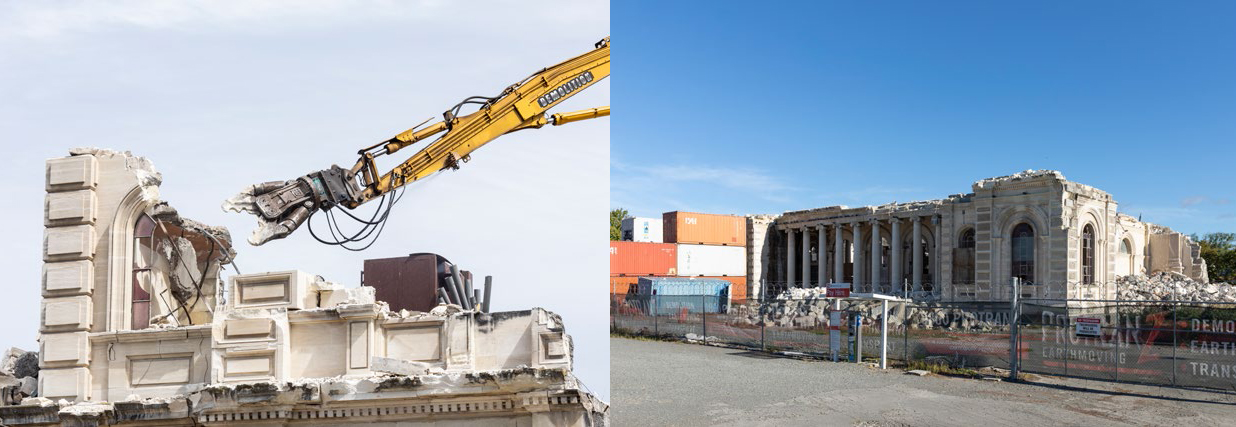
The basilica under demolition.
In June 2016, Brownlee announced the Crown would seek a new contractor to finalise the design and build the centre. The new government-owned company, Otakaro, issued a revised plan for the precinct, comprising a smaller 1400-seat centre with no car park and no adjoining hotels.
On the chessboard that is post-earthquake Christchurch, the convention-centre precinct was a critical piece. Carter had owned land within the planned footprint of precinct — land since bought by the government as part of its acquisition programme for anchor projects.
In 2018, when the bishop asked Sewell to find a site for the new cathedral, Carter and Sewell got talking. They were mates — Sewell was working at Ngai Tahu at the time of the PCNZ bid — and Carter happened to be one of four landowners of a 4340-square-metre central city block identified by Sewell as a possible new home for the Catholic church.
Sewell, a bluff, straight-talking man, is a long-time member of the Catholic Cathedral Management Board and an experienced property player — in his 21 years with Ngāi Tahu, the iwi’s property portfolio grew from $50 to $600 million.
At the time, Carter’s land was a flooded hole where the PricewaterhouseCoopers office tower once stood. Sometimes referred to as “Carter’s swimming pool”, the site was then on the city council’s “Dirty 30” list of derelict structures identified as major obstacles to the rebuild. Would Carter consider selling his land to the diocese? Sewell asked. Carter would — if he could “acquire some alternative land”.
Ōtākaro was a crucial link in the negotiations that followed. Carter would only consider selling his land to the diocese if Ōtākaro allowed the Carter Group to build hotels on the Crown-owned land surrounding the convention centre, now called Te Pae. Emails received under the Official Information Act show that in August 2018, the Diocesan Property Office manager — presumably Sewell — approached Keith Beal, the former property manager for the Catholic church and now Ōtākaro’s general manager of strategy and property. “To be absolutely clear,” the Property Office manager wrote, “without Crown assistance this project cannot proceed and a fantastic opportunity for this city will be lost.”
In December 2019, Ōtākaro, the Carter Group and the Catholic Diocese announced a new hotel precinct as part of the North of the Square project, starting with a five-star hotel alongside Te Pae. Under the agreement with Ōtākaro, the Carter Group will pay for the land over time as the hotels are developed.
The eventual resale of part of the convention centre precinct land back to one of the original owners of that land was a surprise to many. In 2017, Ōtākaro commissioned a real estate agency to market the hotel concept to developers but, according to Ōtākaro’s chief executive John Bridgman, it had “been trying for years to find a developer and operator with no success”. Besides, he notes, “Carter was only prepared to progress the Catholic (precinct) if he would get the opportunity to build the hotels — and we were keen for him to build the hotels.”
Unlike the chronically delayed anchor project programme, the new Catholic precinct is charging ahead. By November, the other three property owners with land on the site had agreed to sell. An architect with ecclesiastical experience has been selected but not officially announced.
Under the joint agreement between Carter and the diocese, the cathedral and office buildings will be built by the diocese; the carpark and apartments will be built jointly with the Carter Group. A small chunk of surplus land will be used for community-based activities or sold on. According to Sewell, all the required land is now earmarked for the cathedral precinct but “some we have only half-bought and [Carter] has retained ownership of part of it”.
Behind a barrier of lined fencing, the demolition of the basilica is almost complete. Some precious items have been saved from the excavator’s claw. Two days before Christmas, a rescue operation by the CBS Music Trust saw the main organ, built in Birmingham in 1878, lifted from its exposed foothold and put into storage. The fate of the large stained-glass window designed by artist Philip Trusttum and a series of Stations of the Cross relief sculptures by the late Llew Summers remains uncertain.
But the new cathedral, says Sewell, will not incorporate much salvaged material. Already two ornate doors and other items from the basilica have been identified in a local demolition yard. Other items, says Sewell, will be sold, donated or “otherwise disposed of”. The magnificent green dome has been given to a group “who want to use it for some religious purpose”.
“We don’t want a whole lot of second-hand stuff going into a new building,” he says, “There is a lot of stuff put in storage but we are not saving it. What do you do with a set of doors off a cathedral?”
The final act will be disinterment of the remains of three bishops buried under the floor of a side chapel. One is John Grimes, the bishop who raised the money for the basilica’s creation.
Christchurch in 2021 is a city with an erratic heartbeat. Visitors scoot, bike or stroll between big-box downtown developments, cafe tables spill out on to widened footpaths. After a slow start, high-spec inner-city apartments are selling fast, mostly to owner-occupiers, a large number to first-time homeowners. An estimated 7000 people now live in the inner city, still short of the council’s goal of 20,000. Elsewhere, expanses of rubble are dotted with Wilson carparks and the few remaining wrecked buildings. As of the beginning of 2020, about 20 per cent of central-city land within the four avenues is vacant.
In the Square, the ChristChurch Cathedral is finally being put back together. The gaping west wall has been plugged with an 18-tonne permanent steel frame. Over the next few years, the building will be strengthened with a new floor slab, base isolators and wall reinforcements, and the tower rebuilt with a staircase, lift and cladding of the original stone. “There is no doubt that some wealthy powerful people drove the challenge to reinstate the cathedral,” concedes Matthews’ successor, the Right Reverend Peter Carrell, “but my conversations with people in Christchurch tell me they represented a wide body of public opinion.”
“This is our heritage reinstatement centrepiece and clearly the other one isn’t going to be,” says project director Keith Paterson. “The broken cathedral became the poster child of the earthquake. We are changing that. It will become an awe-inspiring symbol of life.”
Meanwhile, work will begin on the Catholic precinct in the second half of this year — dislodging hundreds of black-billed gulls, or tarāpuka, the most threatened gull on earth, which have made the mangled foundations of the PricewaterhouseCoopers building their home.
More money is still needed for both projects — around $30 million for the completion of the Catholic cathedral; $51 million for the Cathedral Quarter. On 2 January, the Catholic Church announced Martin had been appointed by Pope Francis as coadjutor archbishop of Wellington, effective immediately. A change of direction is possible under a new bishop but unlikely: the demolition of the basilica and the restructuring of the parishes have already been signed off, and Martin will retain his administrative authority until a new bishop is appointed.
Tony Sewell says the new Catholic cathedral will not include much of the material salvaged from the old one. “We don’t want a whole lot of second-hand stuff going into a new building”.
“At the end of the day,” says Sewell, “we’ll end up with two big magnificent religious buildings right in the heart of the city, which gives everybody a bit of a clear message about the place of Christianity among the other religions in this city.”
It can also be read as a message about the place of Catholicism in the city. The last census shows that in this Church of England settlement, Catholics now outnumber Anglicans, boosted by the growing number of Filipinos and other ethnicities who have moved to the city to work on the rebuild.
From his office in the heart of Christchurch’s retail precinct, Carter is optimistic. “Where else do you get a chance to see a new city grow from an old one? I think it will be one of the most beautiful cities of this part of the world.”
Christchurch mayor Lianne Dalziel is more circumspect — about the Catholic precinct and the direction the rebuild has taken. She chooses her next words carefully. “Sometimes it is more important to put a line in the sand around the decisions you can’t change and look positively forward about the things you are still capable of delivering. When I see our city reflected though the eyes of people who have not been here for a long time, I get a sense of how exciting people feel the city is becoming. So I do have enormous optimism. It is not going to be exactly what the blueprint mapped out and some of the locations I would not have chosen. That said, we will make the most of what we have.”
And the new Catholic cathedral precinct? “It is what it is.”
Sally Blundell is a journalist in Otautahi Christchurch.
This story appeared in the February 2021 issue of North & South.


